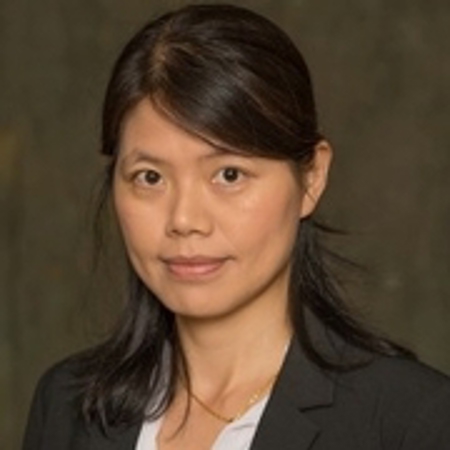Huey-Wen Lin
Associate Professor, Department of Computational Mathematics, Science and Engineering
Associate Professor, Department of Physics & Astronomy
Location: 4208 Biomed Phys Sci
Phone: 517-884-5594
Email: hueywen@msu.edu
Website: http://www.pa.msu.edu/people/hwlin/
Bio
Huey-Wen Lin joined the MSU Department of Physics and Astronomy in 2016 as a high-energy particle (HEP) theorist. She is also associated with the MSU Department of Computational Mathematics, Science & Engineering. Her research focuses on using high-performance supercomputers to calculate the structure and interactions of the building blocks of matter: the proton and neutron. She received a 5-year NSF Faculty Early Career Development Program (CAREER) award effective 01 August 2017 on the research topic [“Constraining Parton Distribution Functions for New-Physics Searches”](https://www.nsf.gov/awardsearch/showAward?AWD_ID=1653405). She is the organizing chair for the [36th Annual International Symposium on Lattice Field Theory](https://web.pa.msu.edu/conf/Lattice2018/). Her statement of professional activities and interests follows. Quantum chromodynamics (QCD) is the theory of the physics that dominates at very small scales, the femtoscale (10?15 m), where fundamental particles (quarks and gluons) are bound inside the nucleons, protons and neutrons, that make up atomic nuclei. This is far smaller than the size of the atoms (10?10 m) which form molecules (nanoscale, 10?9 m) in the materials we are familiar with. What do we learn by considering physics at this tiny scale? For one, we can understand how fundamental particles make up the proton and neutron, and calculate the predictions of the Standard Model with such precision what the LHC will be able to discern the subtle hints of new physics. Further, we may try to see how nucleons interact with each other. At the nuclear level, we can learn how the residual strong force binds nucleons together into the nuclei that form the cores of all atoms, that power the stars and perhaps one day fusion power plants. An understanding of how nuclear structure arises from fundamental physics may hold the key to the question of fine tuning (a mystery relevant to any carbon-based life forms). The interactions between hadrons at small scale also impact objects at the astrophysical scale, such as neutron stars. The strengths of these interactions can be input into descriptions of nuclear matter in simulations of the conditions in the center of neutron stars, where incredible pressure and density could allow exotic forms of matter to exist. Lattice QCD is a discrete version of the continuum QCD theory. The path integral over field strengths at infinitely many Minkowski space-time points is approximated using only finitely many points in a discrete Euclidean space lattice. In momentum-space, this automatically provides both an ultraviolet cutoff at the inverse lattice spacing and an infrared cutoff at the inverse box size. The number of degrees of freedom needed to compute quark properties here is the spatial volume times the number (3) of colors, times the number (4) of spins. The number of spatial points varies, for example, a lattice volume with 643×96 has rank 300M, and it cannot be fit onto a few workstations. A computational cluster with thousands of cores is necessary. Lattice practitioners use systems ranging from small-size clusters hosted at universities to national supercomputer centers such as NERSC. To learn more about lattice gauge theory, I recommend * [Online lecture videos](http://www.int.washington.edu/PROGRAMS/12-2c/Lectures.html) from the lattice-QCD summer school I organized at INT in 2012 * "Lattice Methods for Quantum Chromodynamics", Degrand and De Tar, World Scientific, 2006. * "Introduction to Lattice QCD", Gupta, arXiv:hep-lat/9807028. # Education: * 2006: Ph.D. in Physics, Columbia University
Courses
- PHY 905: Special Problems
Selected Publications
- “Flavor Structure of the Nucleon Sea from Lattice QCD”, Huey-Wen Lin, Jiunn-Wei Chen, Saul D. Cohen, Xiangdong Ji, Phys. Rev. D 91, 054510 (2015), 1402.1462 [hep-ph]
- “Helicity and Transversity Parton Distribution from Lattice QCD”, Jiunn-Wei Chen, Xiangdong Ji, Huey-Wen Lin, and Jian-Hui Zhang, Frontiers Article in Nuclear Physics B911, 246 (2016), 1603.06664 [hep-ph]
- “Neutron Electric Dipole Moment and Tensor Charges from Lattice QCD”, T. Bhattacharya, V. Cirigliano, R. Gupta, H.-W. Lin, B. Yoon, Phys. Rev. Lett. 115, 212002, (2015).
- Invited chapter “Exponential Time Series in Lattice Quantum Field Theory”, S. D. Cohen, G. T. Fleming and H.-W. Lin, in Exponential Data Fitting and its Applications, Bentham eBooks, ISBN:978-1-60805-048-2
- Lattice QCD for Nuclear Physics (Lecture Notes in Physics Series, Book 889), Editors Huey-Wen Lin and Harvey B. Meyer, ISBN: 978-3-319-08021-5 (print), 978-3-319-08022-2 (online) [2014]
